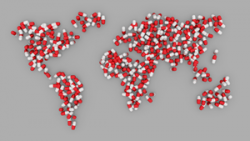The Importance of Drying in the Pharmaceutical Industry - Part 1
Pills have been around since about 1500 BCE, when ancient physicians would mix medicinal plant powders and spices with bread dough, honey or grease, and then form the mixture into little balls to make the medicine easier to take. The ancient Greeks used the word Katapotia, or “something to be swallowed,” to describe these round balls. Roman naturalist Pliny the Elder (23-89 CE) referred to such formulations as pilula, a word that eventually evolved into “pill.”
Archeologists have unearthed grooved pill-makers from ancient Roman ruins. Early drug makers would use clay as an excipient to bind the ingredients of the pill together. Dried herbs and therapeutic compounds would be mashed into clay, pressed into a mold, allowed to dry, and then popped out of the mold.
In a way, pill production today follows a similar process. Drug makers add therapeutic compounds to various wet excipients, mash it into an easy-to-swallow shape, and allow it to dry. Unlike Pliny and other the ancient healers, though, modern drug manufacturers have an advantage when it comes to curing their pills – thermal processing.
Pill Production Today
Pill production has evolved with technology in the centuries since the days of Pliny. Producing pills is now a complex, multi-step process that gives drug manufacturers a great deal of control over the quality, pharmacological activity, bioavailability, and efficacy of the ingredients in pills.
The steps include:
- Formulation – evaluate a compound for uniformity, stability and other factors
- Powder blending – combine the excipients to create the final blend
- Milling – reduce the average particle size to increase homogeneity, dosage uniformity, bioavailability, and solubility
- Granulation – bind smaller particles together to create larger granules, which prevent the “de-mixing” of excipients, improve flow characteristics of powders, and improve compaction properties for proper tablet formulation
- Hot melt extrusion – the application of heat, pressure and agitation to mix the materials, followed by extrusion through a die, which improves dissolution rates and bioavailability
- Direct Blending - Powders are weighed, then blended and made into tablets. There are limited tablets that can be made by this process.
- Wet Granulating - mixing dry primary powder particles with a granulating fluid. Typical liquids used in wet granulation include water, ethanol and isopropanol, either alone or in combination forming bonds. Once a bond is formed, the liquid is removed through thermal drying. Wet Granulation is the primary way powders are processed for tablet pressing.
- Dry Granulating – is a process in which the powders are compacted and then re-grinded which enables the Granulation to be more densely compacted. Typically, this process is used for products that are fine like Talc and too sensitive for Wet Granulating
Stay tuned next month for more on the use of thermal processing in pill production!




